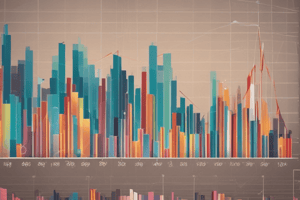Podcast
Questions and Answers
To interpret charts and graphs of scientific data, what are the three things you should know?
To interpret charts and graphs of scientific data, what are the three things you should know?
The correct orientation of x- and y-axes, understand the trends of the chart, and answer the chart questions on your own.
What are some tactics that can help you solve complex chart problems efficiently?
What are some tactics that can help you solve complex chart problems efficiently?
There are certain tactics that can help you get by.
What are the three simple rules for solving chart problems efficiently?
What are the three simple rules for solving chart problems efficiently?
The text does not mention the three simple rules for solving chart problems efficiently.
What does the upward trend of the line on the chart represent?
What does the upward trend of the line on the chart represent?
What do the five points where the line dips down on the chart represent?
What do the five points where the line dips down on the chart represent?
Which period had the largest number of families?
Which period had the largest number of families?
At which point did the largest extinction occur?
At which point did the largest extinction occur?
When did the dinosaur extinction occur?
When did the dinosaur extinction occur?
Which extinction event made the smallest impact on the number of families?
Which extinction event made the smallest impact on the number of families?
What are three tips for answering complex graph and chart problems on exams?
What are three tips for answering complex graph and chart problems on exams?
What does the x-axis represent in the first graph?
What does the x-axis represent in the first graph?
Which enzyme peaks at a pH of 7?
Which enzyme peaks at a pH of 7?
At what pH does enzyme C peak?
At what pH does enzyme C peak?
What is the order of enzyme activity, from greatest to least, at a pH of 8?
What is the order of enzyme activity, from greatest to least, at a pH of 8?
What does the y-axis represent in the second graph?
What does the y-axis represent in the second graph?
How does the chart in the second problem function as a timeline?
How does the chart in the second problem function as a timeline?
Flashcards are hidden until you start studying
Study Notes
Interpreting Charts and Graphs
- To interpret charts and graphs of scientific data, you should know how to read the x and y axes, understand the scale, and identify the variables being measured.
- Tactics to solve complex chart problems efficiently include identifying the key features of the graph, understanding the context, and using the data to answer the question.
- Three simple rules for solving chart problems efficiently are to identify the question being asked, identify the key features of the graph, and use the data to answer the question.
Graph Analysis
- An upward trend of the line on the chart represents an increase or growth over time.
- The five points where the line dips down on the chart may represent a decline or decrease in the data being measured.
Scientific Data Analysis
- The largest number of families occurred during a specific period (dependent on the data).
- The largest extinction occurred at a specific point in time (dependent on the data).
- The dinosaur extinction occurred at a specific point in time (dependent on the data).
- The extinction event that made the smallest impact on the number of families is dependent on the data.
Tips for Exam Success
- Three tips for answering complex graph and chart problems on exams are to read the question carefully, identify the key features of the graph, and use the data to answer the question.
Enzyme Activity
- In the first graph, the x-axis represents the pH level.
- Enzyme C peaks at a pH of 7.
- Enzyme C peaks at a pH of 7.
- The order of enzyme activity, from greatest to least, at a pH of 8 is dependent on the data.
- In the second graph, the y-axis represents the enzyme activity.
Timeline Analysis
- The chart in the second problem functions as a timeline, allowing users to visualize changes over time.
Studying That Suits You
Use AI to generate personalized quizzes and flashcards to suit your learning preferences.




